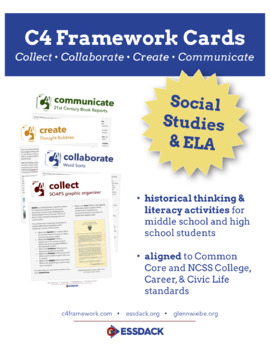Social Studies C4 Cards - Historical Thinking & Literacy (Set Two: Communicate)
ESSDACK
93 Followers
Grade Levels
5th - 12th
Resource Type
Standards
CCSSRH.6-8.1
CCSSRH.6-8.2
CCSSRH.6-8.7
CCSSRH.9-10.1
CCSSRH.9-10.6
Formats Included
- PDF
- Internet Activities
Pages
8 pages
ESSDACK
93 Followers
Compatible with Digital Devices
The Teacher-Author has indicated that this resource can be used for device-based learning.
Description
The C4 Framework has four elements – Collect, Collaborate, Create, and Communicate – that provide a structure for planning and implementing a instructional arc that supports high-quality social studies instruction in grades 5-12.
The Collect Element focuses on gathering and organizing information. The Collaborate Element encourages working together and pooling resources. The Create Element is all about constructing solutions and generating products. And the Communicate Element supports the telling of the story and sharing results.
We’ve created cards for each of the elements that provide practical and research-based strategies that you can use immediately as part of your instruction.
Each card highlights a specific strategy, website, or instructional tool designed to be implemented immediately. Every card is aligned to both the College, Career, and Civic Life standards from the National Council for the Social Studies and the Common Core State Standards for ELA & Literacy in History/Social Studies.
This set of four Create C4 Cards includes:
- HATs & Bubbles
- DocsTeach
- Kahoot
- Fence Sitting
The Collect Element focuses on gathering and organizing information. The Collaborate Element encourages working together and pooling resources. The Create Element is all about constructing solutions and generating products. And the Communicate Element supports the telling of the story and sharing results.
We’ve created cards for each of the elements that provide practical and research-based strategies that you can use immediately as part of your instruction.
Each card highlights a specific strategy, website, or instructional tool designed to be implemented immediately. Every card is aligned to both the College, Career, and Civic Life standards from the National Council for the Social Studies and the Common Core State Standards for ELA & Literacy in History/Social Studies.
This set of four Create C4 Cards includes:
- HATs & Bubbles
- DocsTeach
- Kahoot
- Fence Sitting
Total Pages
8 pages
Answer Key
N/A
Teaching Duration
45 minutes
Report this resource to TPT
Reported resources will be reviewed by our team. Report this resource to let us know if this resource violates TPT’s content guidelines.
Standards
to see state-specific standards (only available in the US).
CCSSRH.6-8.1
Cite specific textual evidence to support analysis of primary and secondary sources.
CCSSRH.6-8.2
Determine the central ideas or information of a primary or secondary source; provide an accurate summary of the source distinct from prior knowledge or opinions.
CCSSRH.6-8.7
Integrate visual information (e.g., in charts, graphs, photographs, videos, or maps) with other information in print and digital texts.
CCSSRH.9-10.1
Cite specific textual evidence to support analysis of primary and secondary sources, attending to such features as the date and origin of the information.
CCSSRH.9-10.6
Compare the point of view of two or more authors for how they treat the same or similar topics, including which details they include and emphasize in their respective accounts.


